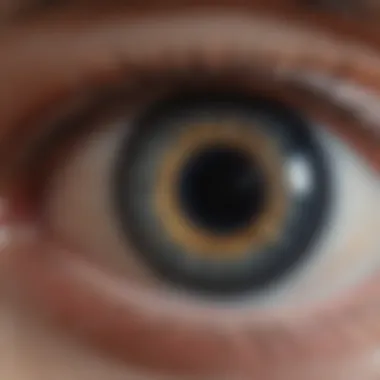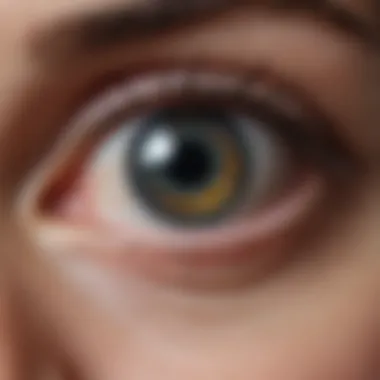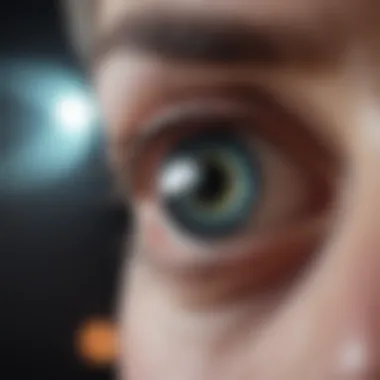Recent Advancements in Keratoconus Research


Intro
Keratoconus presents significant challenges within the field of ophthalmology. This progressive eye disorder progressively alters the corneal shape, leading to varying degrees of visual impairment. Understanding the mechanisms behind keratoconus is crucial for developing enhanced diagnostic and treatment strategies. Recent research endeavors are shining a light on the genetic, environmental, and biochemical factors contributing to this condition, thus opening new avenues for intervention.
Key Concepts
Definition of the Main Idea
Keratoconus is characterized by a conical deformity of the cornea which results in distorted vision. It usually manifests during the teenage years and progresses into early adulthood. The change in the cornea's structure typically leads to myopia and astigmatism, making vision correction increasingly difficult.
Overview of Scientific Principles
Understanding keratoconus involves examining its etiology, which includes genetic predisposition and environmental influences, such as eye rubbing. The cornea undergoes biochemical changes, notably with regard to collagen structure and hydration, prompting the need for advanced research in identifying early markers of the disease.
Current Research Trends
Recent Studies and Findings
"Genetic research into keratoconus could eventually lead to predictive testing and preventative strategies."
"Genetic research into keratoconus could eventually lead to predictive testing and preventative strategies."
Additionally, innovative diagnostic techniques are emerging. Advances in corneal topography and tomography provide detailed mapping of corneal distortions, allowing for earlier detection and intervention.
Significant Breakthroughs in the Field
Key breakthroughs focus on treatment innovations. Cross-linking techniques, such as riboflavin and ultraviolet A (UVA) corneal cross-linking, have been shown to halt the progression of keratoconus in many cases. Moreover, new lenses have been developed. Scleral lenses, for example, offer an alternative to traditional contact lenses by providing better vision correction and comfort for keratoconus patients.
Understanding these trends is vital for clinicians and researchers alike, as comprehensive insight into keratoconus can enhance patient care and prognosis.
Preamble to Keratoconus
Defining Keratoconus
Keratoconus is a progressive eye disorder characterized by a conical deformity of the cornea. This change in shape leads to visual distortions and increased sensitivity to light. The condition typically manifests in the teenage years or early twenties, affecting one or both eyes. It is essential to clearly define keratoconus to facilitate discussions on its physiological implications and treatment options.
Some common symptoms include:
- Blurred or distorted vision
- Increased sensitivity to glare and light
- Frequent changes in eyeglass prescription
- Eye strain and discomfort
In advanced cases, keratoconus can severely impact daily life, making timely diagnosis and intervention vital.
Epidemiology and Prevalence
Epidemiological studies indicate that keratoconus affects approximately 1 in 2,000 people globally. However, its prevalence may vary based on geographic location and ethnicity. Populations with a higher occurrence include those of Middle Eastern and South Asian descent.
Several factors can influence the prevalence of keratoconus:
- Family history: There is a notable genetic component, with higher rates among individuals with affected relatives.
- Environmental factors: Studies suggest that eye rubbing and exposure to UV light may contribute to the condition’s development.
Understanding these epidemiological aspects helps identify at-risk populations, fostering early detection and intervention strategies. Recent advancements in research aim to refine these insights, leading to improved screening methods and tailored treatment approaches.


Pathophysiology of Keratoconus
Understanding the pathophysiology of keratoconus is essential to grasping how this condition affects individuals. This section covers two critical aspects: the corneal structure and its function, and the cellular mechanisms that contribute to the progression of the disease. Recognizing these elements provides insight into potential interventions and helps inform future research directions.
Corneal Structure and Function
The cornea serves a major role as the outermost layer of the eye. Its transparent and dome-shaped structure is vital for vision. The cornea consists of five layers: the epithelium, Bowman's layer, the stroma, Descemet's membrane, and the endothelium. Each layer is essential, as they work together to maintain the eye's refractive power, protect against injury, and control fluid balance.
In keratoconus, this structure becomes weakened due to abnormal biomechanical properties. The stroma, which makes up the bulk of the corneal tissue, undergoes a progressive thinning and distortion. This altered shape causes irregular astigmatism, affecting both vision quality and the patient's daily life. Recognizing these changes helps in identifying the severity of keratoconus and informing treatment options.
Cellular Mechanisms Involved in Progression
At the cellular level, several mechanisms contribute to keratoconus progression. Research indicates that there is a significant imbalance between proteolytic enzymes and their inhibitors in the cornea. This imbalance promotes the breakdown of structural proteins, leading to degradation of collagen fibers.
In addition, keratocytes, specialized cells found in the cornea, exhibit abnormal behavior in keratoconus. These cells normally help maintain corneal transparency and integrity; however, in patients with keratoconus, their function is impaired. This dysfunction is often linked to oxidative stress, which is thought to play a significant role in the pathophysiological changes observed in keratoconus.
"The unraveling of cellular mechanisms in keratoconus opens new avenues for targeted therapies that could halt or even reverse the progression of the disease."
"The unraveling of cellular mechanisms in keratoconus opens new avenues for targeted therapies that could halt or even reverse the progression of the disease."
Moreover, inflammation may also contribute to the disease process. Pro-inflammatory cytokines have been implicated in the pathogenesis of keratoconus, indicating that an inflammatory response could worsen corneal instability.
Genetic Factors in Keratoconus
Understanding genetic factors in keratoconus is fundamental for various reasons. First, it sheds light on the potential for inheritance patterns, particularly for those at risk. Second, identifying these factors can enhance screening processes and improve treatment options. The growing body of research focuses on heritability and specific genetic markers linked to keratoconus. Researchers aim to dissect these genetic underpinnings, which might reveal critical insights into disease mechanisms and therapeutic targets.
Heritability and Family Studies
Heritability studies provide compelling evidence that keratoconus has a genetic component. Family studies have consistently shown that individuals with a family history of keratoconus are at a higher risk of developing the condition compared to the general population. Research has indicated that twins show a higher concordance rate for keratoconus, suggesting a strong genetic influence.
Various studies conducted across different populations reveal that the risk can vary. For instance, a study conducted in a specific cohort showed that first-degree relatives have an odds ratio of approximately 15 times greater for developing the disorder. This data highlights the importance of genetic counseling for affected families.
Identified Genetic Markers
Recent advancements have led to the identification of specific genetic markers associated with keratoconus. Several studies have pinpointed loci on chromosomes that are significantly correlated with the disease. For example, genetic variants located on chromosomes 16 and 20 have shown strong associations.
Among these, the detection of VAX1 and TGFBR3 genes has been of particular interest. These genes are involved in cellular processes that could affect corneal structure and stability.
Furthermore, genome-wide association studies have uncovered additional markers, refining our understanding of the genetic landscape of keratoconus. This discovery opens avenues for potential gene therapy and personalized medicine strategies in the future.
In summary, understanding genetic factors in keratoconus is essential for predicting risk, improving diagnostics, and developing tailored treatments for patients.
In summary, understanding genetic factors in keratoconus is essential for predicting risk, improving diagnostics, and developing tailored treatments for patients.
Diagnostic Approaches
The diagnostic approaches for keratoconus are critical in both identifying and monitoring the disease's progression. Early detection significantly impacts management strategies and treatment outcomes. Accurate and timely diagnoses enable clinicians to tailor interventions to individual patients, potentially slowing the disease's progression and improving quality of life. As keratoconus varies widely in severity, the relationship between diagnostic accuracy and treatment planning is paramount.
Traditional Diagnostic Methods
Traditional diagnostic methods for keratoconus primarily include visual acuity tests, keratometry, and corneal topography. Visual acuity tests assess the clarity of vision and help identify the need for corrective lenses. Keratometry measures the curvature of the cornea, detecting abnormal steepening indicative of keratoconus. Corneal topography provides detailed maps of the corneal surface, revealing irregularities and pinpointing areas affected by the disease.
Despite being reliable, these methods can sometimes miss subtle changes in the cornea. Regular monitoring is essential, as keratoconus can progress undetected in its early stages. Furthermore, accurate assessments are vital for determining the most appropriate corrective strategy, such as glasses, contact lenses, or surgical options.


Advancements in Imaging Techniques
Recent advancements in imaging techniques have improved the detection and monitoring of keratoconus significantly. Technologies such as Scheimpflug imaging and optical coherence tomography (OCT) provide high-resolution images of the cornea's structure. Scheimpflug imaging captures a three-dimensional view of the anterior segment of the eye, enhancing the assessment of corneal thickness and curvature.
These developments not only enhance diagnostic accuracy but also facilitate the identification of early-stage keratoconus. Enhanced imaging allows for better monitoring of disease progression over time, providing an excellent tool for clinicians to adjust treatment plans accordingly. As the understanding of keratoconus evolves, these advanced imaging techniques are becoming integral to the diagnostic process.
Role of Optical Coherence Tomography
Optical coherence tomography (OCT) stands out as a non-invasive imaging technique that plays a pivotal role in keratoconus diagnostics. OCT provides cross-sectional images of the corneal layers, enabling detailed analysis of the corneal structure and its changes. The ability to visualize the cornea at a microscopic level enhances the understanding of keratoconus and guides clinical decisions.
The precision of OCT allows for accurate measurement of corneal thickness, which is crucial in assessing the severity of keratoconus—thinner areas correlate with more advanced stages of the disease. Moreover, OCT is useful in evaluating the results of treatments like corneal cross-linking, offering insights into the treatment's efficacy.
Overall, the integration of OCT into routine clinical practice enhances diagnostic capabilities, leading to improved patient outcomes. It is important to continue exploring these technologies to push the boundaries of keratoconus research and treatment.
Treatment Options for Keratoconus
Keratoconus presents a significant challenge due to its progressive nature. Effective treatment options are crucial for managing the condition and enhancing the quality of life for patients. Each treatment offers unique advantages and considerations that must be evaluated according to the severity of the disease and the individual patient's needs.
Conventional Treatments
Spectacles and Contact Lenses
Spectacles and contact lenses are often the first line of defense in treating keratoconus. They provide a non-invasive solution to help patients achieve clearer vision. The key characteristic of these options lies in their ability to compensate for the distorted corneal shape.
Benefits of Spectacles and Contact Lenses
- Lightweight and easy to use.
- Available in various prescriptions.
- Typically have a lower cost compared to surgical options.
However, as keratoconus progresses, the effectiveness of spectacles may decrease. Many individuals find comfort in contact lenses, specifically rigid gas permeable (RGP) lenses, which can mold to the corneal surface, providing improved visual acuity.
Corneal Cross-Linking
Corneal cross-linking is a relatively recent advancement in keratoconus treatment. This procedure aims to strengthen corneal tissue through the application of riboflavin eye drops and ultraviolet light. The key characteristic of this treatment is its ability to halt the progression of keratoconus.
Unique Features and Considerations
- Non-invasive and relatively straightforward.
- Can be performed in an outpatient setting.
- Significant reduction in the risk of corneal transplant.
Despite its advantages, corneal cross-linking does not reverse corneal distortion. Some patients experience discomfort during the procedure and may require a recovery period.
Surgical Interventions
Intacs and Corneal Transplantation
Surgical interventions, including Intacs and corneal transplantation, are considered for patients with advanced keratoconus. Intacs are small, curved inserts placed in the cornea to flatten its shape, which aids in visual improvement.
Benefits and Challenges
- Intacs are reversible, allowing for adjustments.
- They help delay the need for full corneal transplant.
- However, they may not be suitable for all patients.
Corneal transplantation remains the gold standard for severe cases. This process replaces the diseased cornea with donor tissue, restoring vision effectively.
New Surgical Techniques


Emerging surgical techniques continue to evolve within the field of keratoconus treatment. Techniques such as deep anterior lamellar keratoplasty (DALK) are being explored for their benefits in minimizing complications associated with traditional full-thickness transplants.
Advantages and Disadvantages
- DALK preserves more corneal tissue, reducing rejection rates.
- However, it requires advanced surgical skill and experience.
Overall, the landscape of treatment options for keratoconus is expanding considerably. By tailoring the approach to the unique needs of each patient, the goal is to optimize visual outcomes and enhance everyday functioning effectively. Collaborative research efforts will further refine these techniques, ultimately improving patient care.
Psychosocial Impact of Keratoconus
Keratoconus not only affects the physical health of individuals but also significantly impacts their psychosocial well-being. These patients often grapple with visual impairment, which can lead to feelings of anxiety, depression, and social isolation. Understanding the psychosocial implications is paramount, as it helps in crafting a holistic approach to treatment. Without addressing the emotional and social aspects of living with keratoconus, even the most successful medical interventions can fall short.
Quality of Life Considerations
Quality of life is a vital measure when assessing the impact of keratoconus. The progressive nature of the disease can cause significant disruptions in daily activities. Many patients experience difficulties in driving, reading, and performing other tasks that require clear vision. This diminished visual acuity can also result in a decline in professional performance and academic achievement.
- Emotional Distress: Patients frequently report increased levels of stress and frustration due to their condition. The uncertainty surrounding the progression of keratoconus can exacerbate these feelings.
- Social Withdrawal: Individuals may shy away from social situations, fearing judgment about their appearance or abilities. This avoidance can lead to loneliness and further psychological challenges.
- Impact on Self-Esteem: The visible symptoms, such as bulging corneas, can affect a person's self-image. The lack of understanding from others can intensify feelings of inadequacy.
Addressing these quality of life issues necessitates a multidisciplinary approach that may include counseling and support groups. Creating strategies to manage emotional health is essential for enabling patients to lead fulfilling lives despite their diagnosis.
Support Systems for Patients
A robust support system can dramatically improve the psychosocial experience for individuals with keratoconus. Patients benefit from both formal and informal networks that provide emotional assistance, practical advice, and educational resources.
- Family and Friends: The role of close relationships cannot be overstated; loved ones can provide emotional support and understanding through the ups and downs of managing keratoconus.
- Healthcare Providers: Eye care professionals should address not just the physical aspects of keratoconus but also the emotional and psychological needs of patients. This holistic care can include referrals to psychologists or counselors.
- Support Groups: Peer support groups enable patients to share experiences and coping strategies. These groups can be invaluable in fostering a sense of community and mutual understanding.
- Online Resources: Platforms such as Facebook and Reddit offer forums for individuals with keratoconus to connect. These virtual spaces can provide comfort and create an opportunity for sharing valuable insights about living with the disease.
Future Directions in Keratoconus Research
Emerging Research Trends
One notable trend is the increasing use of genomics in understanding keratoconus. Recent studies have identified specific genetic markers associated with the disease. This knowledge leads to a better understanding of its progression and could eventually aid in targeted therapies.
Another area of focus is the development of novel imaging technologies. High-resolution imaging techniques, such as optical coherence tomography (OCT), enable more detailed visualization of corneal structures. This advancement allows researchers and clinicians to diagnose keratoconus earlier and monitor its progression more effectively.
Additionally, bioengineering approaches are being explored, particularly regarding corneal cross-linking techniques. These innovations may help to halt or even reverse corneal degeneration, enhancing treatment outcomes for patients. Here are some specific trends noted in recent research:
- Advancements in genetic screening and diagnostic tools.
- Use of artificial intelligence to analyze imaging data and predict disease progression.
- Research into pharmacological therapies that could complement surgical procedures.
Role of Collaborative Research
Collaboration among researchers, institutions, and healthcare providers is critical in advancing keratoconus research. Recently, there has been a shift towards larger multi-center studies that pool data and resources. Collaborative efforts not only broaden the scope of research but also increase the statistical power of studies. This increased power can uncover subtleties in the pathophysiology of keratoconus that may have previously gone unnoticed.
The End
Summarizing Key Findings
Recent research advances in keratoconus have underscored the multifaceted nature of the disease. Important points include:
- Genetic Contributions: Studies have illuminated the heritability of keratoconus, identifying specific genetic markers that facilitate early detection and potential preventive measures.
- Diagnostic Innovations: The integration of advanced imaging technologies such as optical coherence tomography provides a clearer understanding of corneal changes, making it easier for clinicians to diagnose and monitor disease progression.
- Evolution of Treatments: Innovations in treatment options, including corneal cross-linking and new surgical techniques like Intacs, have enhanced the management of keratoconus, offering improved outcomes for patients.
These findings are notable for their practical implications. Enhanced understanding of the disease through genetic and diagnostic frameworks leads to more tailored and effective treatment strategies, ultimately resulting in better patient care.
Implications for Future Research
The journey of keratoconus research is ongoing, with several avenues ripe for exploration. Future research should prioritize:
- Longitudinal Studies: These can provide insights into the long-term efficacy of current treatments, allowing practitioners to refine their approaches based on patient responses.
- Genetic Studies: There is a clear need for larger, multicenter studies to validate and expand understanding of genetic markers associated with keratoconus. This aspect could greatly influence early intervention strategies.
- Collaboration Across Disciplines: As indicated in previous sections, cross-disciplinary collaboration will enhance innovation in diagnostics and treatment modalities. Engaging various stakeholders can promote comprehensive solutions.
Overall, the implications for future research highlight the ongoing complexity of keratoconus as a condition that necessitates continued investigation across multiple domains. The insights gleaned from current studies will shape the landscape of both research and clinical practice in the years to come.







